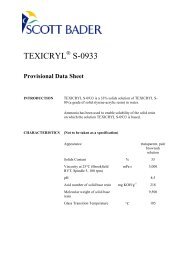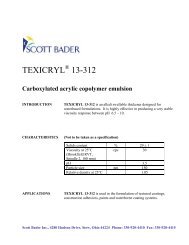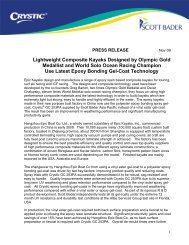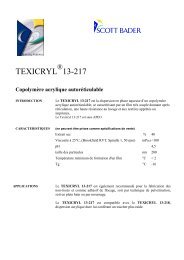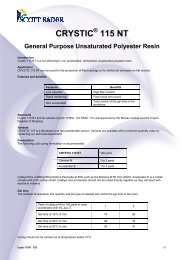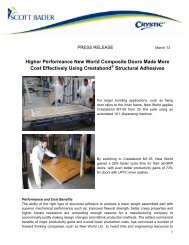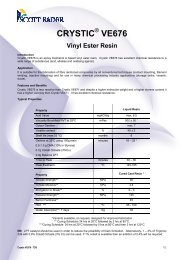Crystic Crestomer® Structural Adhesives - Scott Bader
Crystic Crestomer® Structural Adhesives - Scott Bader
Crystic Crestomer® Structural Adhesives - Scott Bader
You also want an ePaper? Increase the reach of your titles
YUMPU automatically turns print PDFs into web optimized ePapers that Google loves.
<strong>Crystic</strong> Crestomer ®<br />
<strong>Structural</strong> <strong>Adhesives</strong><br />
Range and Application Guide
Introduction<br />
<strong>Crystic</strong> Crestomer ® structural adhesives are used in a wide range of demanding applications in a variety of<br />
markets. The key features and benefits for customers are:<br />
●<br />
●<br />
●<br />
●<br />
Improved structural performance.<br />
Productivity gains through significantly reduced construction times.<br />
Low VOC emissions.<br />
Considerable weight savings.<br />
Stronger Lighter Quicker Tougher<br />
A Record of Achievement<br />
The <strong>Crystic</strong> Crestomer pedigree was established over 25 years ago. The first commercial application for <strong>Crystic</strong><br />
Crestomer adhesive was in the manufacture of minehunters. The unique properties of <strong>Crystic</strong> Crestomer ensured<br />
peel and crack resistance was significantly improved. <strong>Crystic</strong> Crestomer is the only successful material specifically<br />
designed to meet this demanding application.<br />
Challenging Mindsets<br />
<strong>Crystic</strong> Crestomer’s outstanding<br />
performance record and unique<br />
properties have fundamentally<br />
challenged conventional thinking<br />
among moulders, who have been<br />
sceptical of the performance<br />
possibilities with adhesives. Freed<br />
from the constraints of traditional<br />
fabricating techniques, FRP<br />
moulders are now capitalising on the<br />
design flexibility and time and cost<br />
savings that structural adhesives<br />
can offer. <strong>Crystic</strong> Crestomer is now<br />
used in a wide range of demanding<br />
applications across the marine,<br />
transport, building and construction<br />
sectors of the FRP industry.<br />
Princess Yachts International (front cover and above left) and the Vosper Thorneycroft built minesweeper (above) all use<br />
<strong>Crystic</strong> Crestomer products for demanding structural bonding applications.
Chemistry and Bonding<br />
The combination of strength, resilience and flexibility is due to the novel structure of urethane acrylate resins.<br />
The urethane component is fully reacted into the molecular backbone, thus contributing adhesive properties without<br />
the hazard associated with free di-isocyanates. The acrylate saturation and the styrene monomer impart thermoset<br />
characteristics. The backbone of <strong>Crystic</strong> Crestomers impart toughness strength and flexibility. The resulting balance of<br />
properties makes the <strong>Crystic</strong> Crestomer range ideal as a structural adhesive with the following features.<br />
●<br />
●<br />
●<br />
●<br />
●<br />
Excellent adhesion to substrates, fibres, core materials and cured laminates.<br />
Toughness, resilience and flexibility.<br />
Superior fatigue resistance compared to a typical flexible polyester.<br />
Cured with cobalt and amine accelerators and conventional peroxide catalysts.<br />
Low exotherm and high strength even in thick sections.<br />
The curing characteristics of <strong>Crystic</strong> Crestomer adhesives have been designed to be as similar as possible to the curing<br />
characteristics of unsaturated polyester resins. Currently cobalt/MEKP and amine/BPO curing systems are available to<br />
initiate the cross-linking reaction between styrene monomer and the unsaturated urethane-acrylate polymer chain at<br />
room temperature.<br />
The effectiveness of the adhesive bond depends upon the:<br />
●<br />
●<br />
●<br />
●<br />
Surface conditions and the surface energy of the substrates being joined.<br />
Ability of the adhesive to thoroughly wet the substrate surfaces at a micro, or even, a molecular level.<br />
Ability of the adhesive to cure with minimal shrinkage, hence, reducing the level of induced stresses<br />
in the bond-line during the curing process.<br />
Ability of the adhesive to chemically bond to the substrates.<br />
<strong>Crystic</strong> Crestomer adhesives have been designed with the above factors in mind and utilise both polyurethane and<br />
acrylic technologies, which form the basis of two families of adhesives in their own right. The benefits of these<br />
adhesives are combined in <strong>Crystic</strong> Crestomers.<br />
<strong>Crystic</strong> Crestomer adhesives readily wet substrate surfaces and because they contain low cross-link density, induced<br />
bond-line stresses are minimised. The cross linking is such that optimum mechanical performance is achieved within<br />
the adhesive itself, so reducing the possibilities of cohesive failure within the <strong>Crystic</strong> Crestomer adhesive.<br />
Bonds and Bond Strength<br />
Bonded joints can be subjected to a variety of forces (see below). It is, therefore, essential to take into account the<br />
design requirements of bonded joints with respect to these forces. A bonded joint should be designed to meet the most<br />
severe loading case with an adequate factor of safety. The resistance of the joint and the adhesive to peeling forces<br />
generally limits composite bonded joints. In terms of the joints and adhesives resistance to loads, peel forces are the<br />
most destructive, followed by shear loads and tensile loads. Bonded joints are generally very resilient to compression<br />
loading conditions. Hence, joint design is as much a contributor to successful bonded joint performance as the<br />
properties of the adhesive itself.<br />
Examples of Forces<br />
Shear<br />
Tension<br />
Compression<br />
Peel<br />
Peel forces are very<br />
destructive and joint design<br />
should be such as to minimise<br />
this loading condition.
Product Range Overview<br />
<strong>Crystic</strong> Description Approvals Appearance *Gel Tensile Tensile Elongation Performance<br />
Crestomer Time Strength Modulus at Break Characteristics<br />
Product (mins) (MPa) (MPa) (%)<br />
1152PA High Performance Lloyds Mauve Gel *50 26 1400 100 <strong>Structural</strong> adhesive<br />
<strong>Structural</strong> Adhesive Acceptance for demanding<br />
DNV<br />
applications<br />
RINA<br />
1153PA High Performance Lloyds Mauve Gel *90 26 1400 100 Long gel time structural<br />
<strong>Structural</strong> Adhesive Acceptance adhesive for demanding<br />
With Long Open Time<br />
applications on large<br />
components<br />
1186PA Multi Purpose Lloyds Grey Paste *50 14 800 6 High strength gap<br />
<strong>Structural</strong> Adhesive Acceptance filling adhesive<br />
1196PA <strong>Structural</strong> Lloyds Pink Paste *50 20 1300 4 Low density adhesive<br />
Core Bonding Acceptance specifically developed<br />
Adhesive DNV for demanding core<br />
RINA<br />
bonding applications<br />
1151A Advantage Adhesive Lloyds Green / **25 22 500 >100 <strong>Structural</strong> adhesive<br />
for Bulk Application. Acceptance Yellow Gel for demanding<br />
Amine Accelerated RINA applications<br />
Advantage High Performance Lloyds White Paste 30 15 340 >85 High performance<br />
30 <strong>Structural</strong> Adhesive Acceptance structural adhesive<br />
Pre-Packed in DNV for convenience<br />
Cartridges RINA and flexibility<br />
*2% Butanox ® M-50 at 25 0 C **2% Perkadox ® BT-50 at 25 0 C<br />
Packaging and Equipment<br />
The <strong>Crystic</strong> Crestomer range is available in kegs (pails) with some<br />
products also supplied in drums. Crestomer Advantage 30 is packed in<br />
380ml cartridges. Manual and pneumatic guns plus static mixers are<br />
also on the product range.<br />
Azimut use <strong>Crystic</strong> Crestomer.
Bond Strengths with<br />
Different Substrates<br />
<strong>Crystic</strong> Crestomer can be used to bond many substrates. The following tables give typical examples<br />
of bond failure rates and types of failure observed when bonding various substrates with different<br />
products from the <strong>Crystic</strong> Crestomer range.<br />
All figures shown are for lap shear strengths (MPa)<br />
<strong>Crystic</strong><br />
Crestomer<br />
1152PA<br />
Results achievable with <strong>Crystic</strong><br />
Crestomer Advantage and<br />
<strong>Crystic</strong> Crestomer 1153PA are<br />
similar to those shown right<br />
FRP Marine Ply Aluminium Stainless Steel<br />
FRP 10 - - -<br />
Marine Ply - 5 - -<br />
Aluminium - - 15 -<br />
Stainless Steel - - - 12<br />
<strong>Crystic</strong><br />
Crestomer<br />
1186PA<br />
FRP Marine Ply Aluminium Stainless Steel<br />
FRP 10 - - -<br />
Marine Ply - 5 - -<br />
Aluminium - - 10 -<br />
Stainless Steel - - - 8<br />
<strong>Crystic</strong><br />
Crestomer<br />
1196PA<br />
Balsa<br />
(80kg/m3)<br />
FRP 10 6<br />
PVC Foam<br />
Substrate Failure<br />
Cohesive Failure<br />
Fillet joints constructed using <strong>Crystic</strong> Crestomer 1152PA are stronger<br />
and aesthetically superior to FRP laminated joints as well as being<br />
quicker to manufacture and giving far lower styrene emission.<br />
There are three different ways in which a joint can fail.<br />
Cohesive Failure<br />
Substrate<br />
Adhesive<br />
failure modes<br />
Substrate failure<br />
indicates that the adhesive is stronger than the materials<br />
being bonded together.<br />
Adhesive<br />
Substrate<br />
Cohesive failure<br />
is a failure of the bulk adhesive itself and is characterised by<br />
a film of adhesive being left on both sides of the failed bond.<br />
Adhesive failure<br />
occurs in the bond line between the adhesive and substrate<br />
and is characterised by the film of adhesive being left on one<br />
side of the failed joint.<br />
Adhesion<br />
Failure<br />
Substrate<br />
Failure
Comparisons with<br />
Competitive Materials<br />
<strong>Crystic</strong> Crestomer adhesives are one of a wide variety of materials that can be used to bond substrates.<br />
Compared to other adhesives, <strong>Crystic</strong> Crestomers offer the following benefits:<br />
● Monomer type identical to<br />
polyester resins.<br />
● Cured with conventional peroxides.<br />
● Low exotherm during cure.<br />
● Available in a range of gel<br />
and curing times.<br />
● Ease of application.<br />
● Cost effective.<br />
MPa<br />
10<br />
8<br />
6<br />
4<br />
2<br />
0<br />
GRP to GRP<br />
Bond Strength<br />
Bonding<br />
Paste<br />
2-Part PU<br />
Laminated<br />
Joint<br />
Methacrylate<br />
<strong>Crystic</strong><br />
Crestomer<br />
Advantage<br />
High exotherm in an adhesive can<br />
cause the substrate to distort and<br />
give poor aesthetic characteristics<br />
to the parts being bonded.<br />
The chemistry of <strong>Crystic</strong> Crestomer<br />
adhesives ensures that high<br />
exotherm temperatures,<br />
a characteristic of some other<br />
adhesives do not occur. The graph<br />
shows the exotherm temperatures<br />
of <strong>Crystic</strong> Crestomer adhesives<br />
over a range of test temperatures.<br />
Exotherm 0 C<br />
Exotherm of <strong>Adhesives</strong><br />
Crestomer Advantage<br />
Temperature of Test
<strong>Crystic</strong><br />
Crestomers<br />
in Action<br />
Marine<br />
<strong>Crystic</strong> Crestomer products have been successfully used by<br />
leading European boatbuilders to improve the performance of their<br />
products, to make productivity improvements through time savings<br />
in construction and to provide considerable weight savings.<br />
The following diagram shows areas where <strong>Crystic</strong> Crestomer<br />
structural adhesives can be used in FRP boatbuilding.<br />
Small Fixings<br />
Crestomer Advantage<br />
30 cartridges<br />
Deck to Hull Bonding<br />
Crestomer 1152PA<br />
Crestomer 1153PA<br />
Crestomer 1186PA<br />
Crestomer Advantage 30<br />
Core Bonding<br />
Crestomer 1196PA<br />
Bulkhead Bonding<br />
Crestomer 1152PA<br />
Crestomer 1153PA<br />
GELCOAT<br />
PRIMED PVC<br />
OR BALSA CORE<br />
Engine Bed Stiffeners /<br />
Stringer Bonding<br />
Crestomer 1152PA<br />
Crestomer 1153PA<br />
Crestomer 1186PA<br />
LAMINATE<br />
Fillet joints using Crestomer<br />
Bulkhead fixing<br />
viewed from above
<strong>Scott</strong> <strong>Bader</strong><br />
Composites Europe<br />
HEAD OFFICE<br />
<strong>Scott</strong> <strong>Bader</strong> Company Limited<br />
Wollaston<br />
England<br />
Tel: +44 1933 663100<br />
Fax: +44 1933 666139<br />
email: composites@scottbader.com<br />
<strong>Scott</strong> <strong>Bader</strong> Ireland<br />
Dublin<br />
Ireland<br />
Tel: +353 1801 5660<br />
Fax: +353 1801 5657<br />
email: composites@scottbader.ie<br />
<strong>Scott</strong> <strong>Bader</strong><br />
Group Companies<br />
<strong>Scott</strong> <strong>Bader</strong> Inc<br />
Stow, OH<br />
USA<br />
Tel: +1 330 920 4410<br />
Fax: +1 330 920 4415<br />
email: info@scottbaderinc.com<br />
<strong>Scott</strong> <strong>Bader</strong> SA<br />
Amiens<br />
France<br />
Tel: +33 3 22 66 27 66<br />
Fax: +33 3 22 66 27 80<br />
email: composites@scottbader.fr<br />
<strong>Scott</strong> <strong>Bader</strong> Scandinavia AB<br />
Falkenberg<br />
Sweden<br />
Tel: +46 346 10100<br />
Fax: +46 346 59226<br />
email: composites@scottbader.se<br />
<strong>Scott</strong> <strong>Bader</strong> (Pty) Limited<br />
Hammarsdale<br />
Republic of South Africa<br />
Tel: +27 31 736 8500<br />
Fax: +27 31 736 8511<br />
email: composites@scottbader.co.za<br />
<strong>Scott</strong> <strong>Bader</strong> Iberica<br />
Barcelona<br />
Spain<br />
Tel: +34 93 553 1162<br />
Fax: +34 93 553 1163<br />
email: composites@scottbader.es<br />
<strong>Scott</strong> <strong>Bader</strong> Eastern Europe<br />
Liberec<br />
Czech Republic<br />
Tel: +420 48 5228 344/5111 255<br />
Fax: +420 48 5228 345/5111 254<br />
email: composites@scottbader.cz<br />
<strong>Scott</strong> <strong>Bader</strong> Middle East Limited<br />
Jebel Ali<br />
Dubai<br />
Tel: +971 488 35025<br />
Fax: +971 488 35319<br />
email: info@scottbader.co.ae<br />
<strong>Scott</strong> <strong>Bader</strong> Germany<br />
Zur Drehscheibe 5<br />
D - 92637 Weiden<br />
Germany<br />
Tel: +49 961 401 84474<br />
Fax: +49 961 401 84476<br />
email: composites@scottbader.de<br />
<strong>Scott</strong> <strong>Bader</strong> d.o.o.<br />
10 000 Zagreb<br />
Zitnjak BB<br />
Croatia<br />
Tel: +385 1 240 6440<br />
Fax: +385 1 240 4573<br />
email: info@scottbader.hr<br />
<strong>Scott</strong> <strong>Bader</strong> Asia Pacific<br />
Shanghai 200042<br />
China<br />
Tel: +86 (21) 52987778 / +86 (21) 52988887<br />
Fax: +86 (21) 52988889<br />
email: info@scottbader.cn<br />
Leading composites innovation for over 60 years<br />
Visit us at:<br />
U.K Crestomer 5/10





